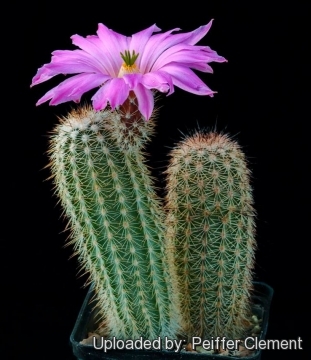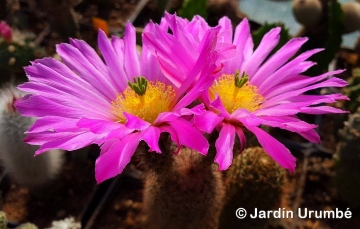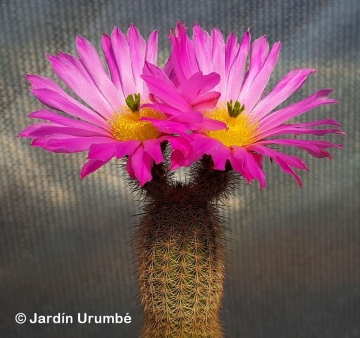
Echinocereus sciurus subs. floresii Photo by: Peiffer Clement
Origin and Habitat: Sinaloa, Mexico.
Altitude: 10-200.
Habitat: Echinocereus floresiiSN|8685]]SN|8685]] grows in inner lowlands fairly close to the coast among Ocotillo (Fouquieria sp.) and Jatropha shrubs on volcanic, rocky clay. In the same area it is possible to find several cactus and succulent species like: Ferocactus emoryiSN|21495]]SN|21495]], Mammillaria swingleiSN|9261]]SN|8817]], Mammillaria sinaloensisSN|8816]]SN|32538]], Mammillaria bocensisSN|23729]]SN|23729]], Mammillaria sheldoniiSN|32538]]SN|8816]], Mammillaria occidentalisSN|8817]]SN|9261]], Peniocereus diguetii, Peniocereus gregii, Peniocereus marianus, Marshallocereus thurberiSN|8268]]SN|8268]], Pachycereus pecten-aboriginumSN|8498]]SN|8498]] and Ibervillea sonoraeSN|21231]]SN|21231]].
Synonyms:
See all synonyms of Echinocereus sciurus
Description: Echinocereus sciurusSN|21864]]SN|8681]] subs. floresii, also known as Echinocereus floresiiSN|8685]]SN|8685]], distingushes from standard Echinocereus sciurusSN|8681]]SN|8681]] for its smaller flowers only 5 cm long and 7 cm in diameter, well below the stem tips.
Note: Marshall placed Echinocereus floresiiSN|8685]]SN|8685]] in the synonymy of Echinocereus bristoliiSN|8681]]SN|21864]].
Habit: It is a densely cespitose cactus species, with numerous short, upright heads that can form clumps to 30 cm in diameter.
Roots: Tuberous.
Stems: Slender, short, mostly erect, cylindrical, tapered toward the tips, often 25 cm tall, and 4 cm in diameter partially hidden by the many short dense spines.
Areoles: Small at first woolly, becoming naked 5-8 mm apart on the same rib.
Spines: Many flexible more or less appressed.
Flower: Bright pink 5 cm long, 7 cm in expansion when fully open occurring down the sides of the plant. Ovary and tube densely spinose. Stigma lobes green. Self sterile.
Blooming season: Late spring.
Fruits: Subglobose, reddish green with white pulp.
Seeds: 1 mm long, tuberculate.
Bibliography: Major references and further lectures
1) Forrest Shreve, Ira Loren Wiggins “Vegetation and Flora of the Sonoran Desert” Volume 1 Stanford University Press, 1964
2) Edward Anderson “The Cactus family” Timber Press, Incorporated, 2001
3) James Cullen, Sabina G. Knees, H. Suzanne Cubey "The European Garden Flora Flowering Plants: A Manual for the Identification of Plants Cultivated in Europe, Both Out-of-Doors and Under Glass" Cambridge University Press, 11/Aug/2011
4) David R Hunt; Nigel P Taylor; Graham Charles; International Cactaceae Systematics Group. "The New Cactus Lexicon" dh books, 2006
5) Urs Eggli, Leonard E. Newton: “Etymological Dictionary of Succulent Plant Names” Springer, Berlin/Heidelberg 2010
6) Ulises Guzmán, Salvador Arias, Patricia Dávila "Catálogo de cactáceas mexicanas." Universidad Nacional Autónoma de México, Mexiko-State 2003
7) León de la Luz, J.L., Hernández, H.M. & Gómez-Hinostrosa, C. 2013. Echinocereus sciurus. In: IUCN 2013. “IUCN Red List of Threatened Species.” Version 2013.2. <www.iucnredlist.org>. Downloaded on 11 January 2014.
 Echinocereus sciurus subs. floresii Photo by: Peiffer Clement
Echinocereus sciurus subs. floresii Photo by: Peiffer Clement Echinocereus sciurus subs. floresii Photo by: Alexander Arzberger
Echinocereus sciurus subs. floresii Photo by: Alexander Arzberger Echinocereus sciurus subs. floresii Photo by: Alexander Arzberger
Echinocereus sciurus subs. floresii Photo by: Alexander ArzbergerSend a photo of this plant.The gallery now contains thousands of pictures, however it is possible to do even more. We are, of course, seeking photos of species not yet shown in the gallery but not only that, we are also looking for better pictures than those already present.
Read More... Cultivation and Propagation: Echinocereus sciurusSN|8681]]SN|8681]] subsp. floresii is of relatively easy culture, but has a massive, deep, tuberous root system below the soil and is prone to rot.
Soil: Use a loose well drained cactus mix.
Repotting: It require a deep pot suited to accommodate the swollen root, repotting with fresh potting-mix should be done every other year or when the plant has outgrown its pot. However, repotting doesn't necessarily mean they'll need larger containers.
Sun Exposure: Light shade when young, full sun later. Outside it likes strong sunshine, but is tolerant and do well with light shade during the hot Summer months, inside it needs bright light, and some direct sun. Tends to bronze in strong light, which encourages spine production.
Hardiness: Winter care presents no problems at temperatures from 5 to 15 degrees centigrade with plenty of light, but frost hardy to -5°C for short periods if very dry.
Watering: They require moderately watering through the growing season. This can be done weekly or more frequently during the summertime, if the weather is sunny enough, but allow to dry fully before watering again. Kept this way, plants will show a healthy growth. Keep rather dry as soon as the temperature starts dropping in October and keep it dry in winter. The plant survives outside without protection in winter (cold hardy to -5° ) but is then somewhat prone to rot, too.
Fertilization: Give an occasional high potassium liquid feed during the active growing period.
Garden uses: Excellent as landscape or patio plant. It is suitable for “desert” gardens, in association with other xerophytes. Where the open air cultivation is not possible due to the climate, it is to be cultivated in pot in order to shelter it in winter. It look fine in a cold greenhouse and frame.
Pest and diseases: They are generally fairly easy to grow, especially if kept pest-free. They are susceptible to, scale insects and spider mite. Watch carefully for infestations of stem and root mealy bugs, and damage from these may well initiate fungal attack.
Propagation: Easy to propagate from cuttings or seeds. Take cuttings spring or summer, let them dry till the ends callous well. Then replant them in fresh cactus soil that is ever so slightly moist, and keep it that way till they root. Surface sowing is the best; seeds germinate in 14-28 days at 20° C, remembering that seedlings dislike strong light and dry conditions.













